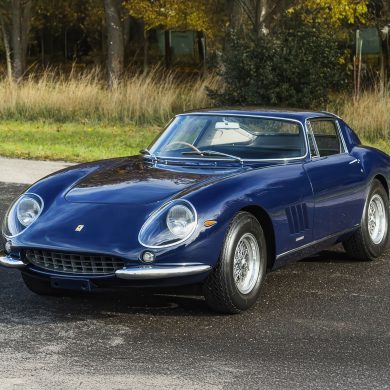
One of the final projects the team was working on at Ferrari was the 250 GTO racer, which was eventually completed by a young Mauro Forghieri. Among the first ones in line to acquire an example for the 1962 season was Count Giovanni Volpi di Misurata for his Scuderia Serenissima Republica di Venezia (SSR) to campaign. When Enzo Ferrari found out Count Volpi was one of the financial backers of the ATS team, he understandably refused to deliver a GTO. Through some friends he did eventually get an example, but he wanted more for his assault at Le Mans that year.
In his stable the Count had a very fast ‘SEFAC Hot Rod’ spec 250 GT SWB (s/n 2819 GT), which had shown its potential in the 1961 Tour de France in the hands of Olivier Gendebien. Unable to obtain a second GTO, Volpi decided to have his SWB brought up to GTO specs and who better to hire for that than Giotto Bizzarrini? More than happy to oblige, the talented engineer set out to turn 2819 GT into an even more extreme racer than the GTO already was. The car was transferred to Piero Drogo’s workshop and upgraded by Bizzarrini in an incredibly short period of time.
His first objective was to mount the engine as far back and as low as possible to obtain an ideal centre of gravity. The V12 was fitted completely behind the front axle; 12 cm further back than in the GTO. A dry-sump lubrication system was fitted to allow the engine to be mounted considerably lower. Similar to the GTO a six Weber carb setup was fitted boosting the power to 300 bhp. The only item missing compared to Ferrari’s GTO was a five speed gearbox, so the hybrid GTO had to make do with the old SWB four speeder. To round things off GTO wheels and tires were fitted.
Although the technical changes greatly improved the car’s performance, it is not what the Count’s GTO hybrid would become famous for. That was all due to the aerodynamic body Bizzarrini had designed for it. At first it might look similar in design to the GTO body, but closer inspection reveals that is even lower and features a much sharper nose. It was so low that a plastic cover was required to cover the Webers that pierced through the engine cover. The roofline carried on all the way to the rear end where it was sharply cut-off to create an extreme Kamm style tale.
Upon completion the Count was rightfully impressed with his new racer that was 100 kg lighter than a GTO, more aerodynamically efficient and equally powerful. It was part of a three car entry for Le Mans together with the GTO and a Ferrari 250 TR/61. Soon after its arrival Bizzarrini’s unusual rear-end design earned it the nickname ‘camionette’, French for little truck, or most commonly ‘Breadvan’ in English. Under pressure from Ferrari the organizers placed the ‘Breadvan’ in the prototype class, instead of the GT class with the GTOs. In the race it outpaced all other GTs in the first hours, but a broken driveshaft meant the end of the race.
It was campaigned four times more in the season scoring two GT class victories and a class track record. It was obvious that the ‘Breadvan’ could easily match the competition’s pace, but the limited resources and time available for proper development prevented it from attaining Ferrari’s incredible reliability. After SSR was disbanded in 1963, the Count frequently used the car on the road before he loaned it to Fiat supremo Gianni Agnelli. He had his butler paint it black as a joke because he thought it looked like a hearse. Volpi eventually sold it in 1965 after which it changed hands a few time before finding longtime ownership in the United States in 1986.
The new owner had the car restored and entered it in the 250 GTO 25th Anniversary run in 1987. The car was not as well accepted by everybody in the Ferrari community who argued it was no longer a Ferrari. After rare outings in the 1980s and 1990s, the ‘Breadvan’ was offered for sale in Christie’s 2005 Monterey Jet Center Auction where it was expected to sell for $3.5 – 5 million. With the number of potential buyers limited by the exceptionally cramped driving position and the high reserve it was no surprise that a new owner was not found.
[Source: Ultimatecarpage.com]
Onboard video of the Breadvan driven by Max Werner and Claudia Huertgen to victory during the 2008 Mugello Historic Festival











